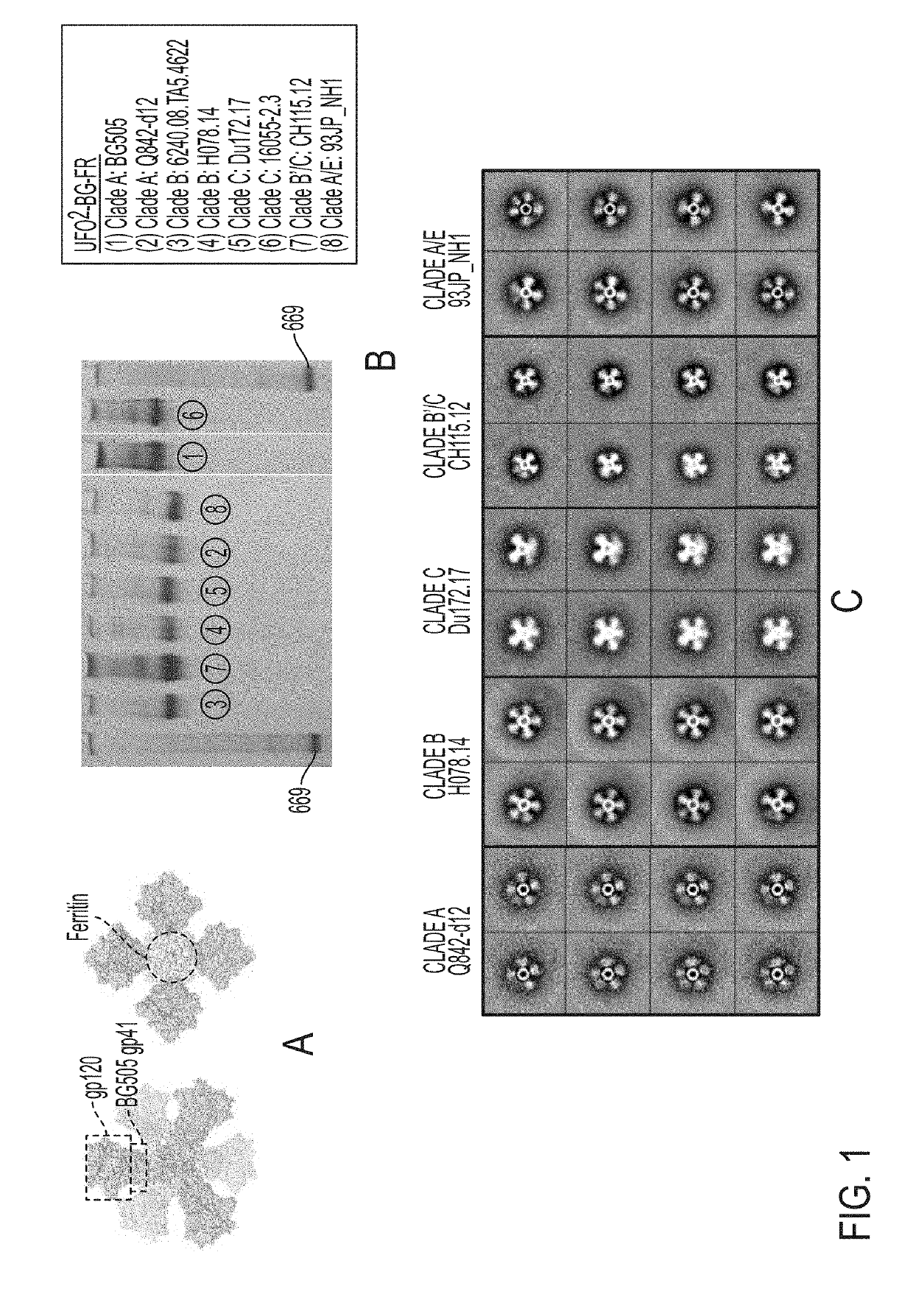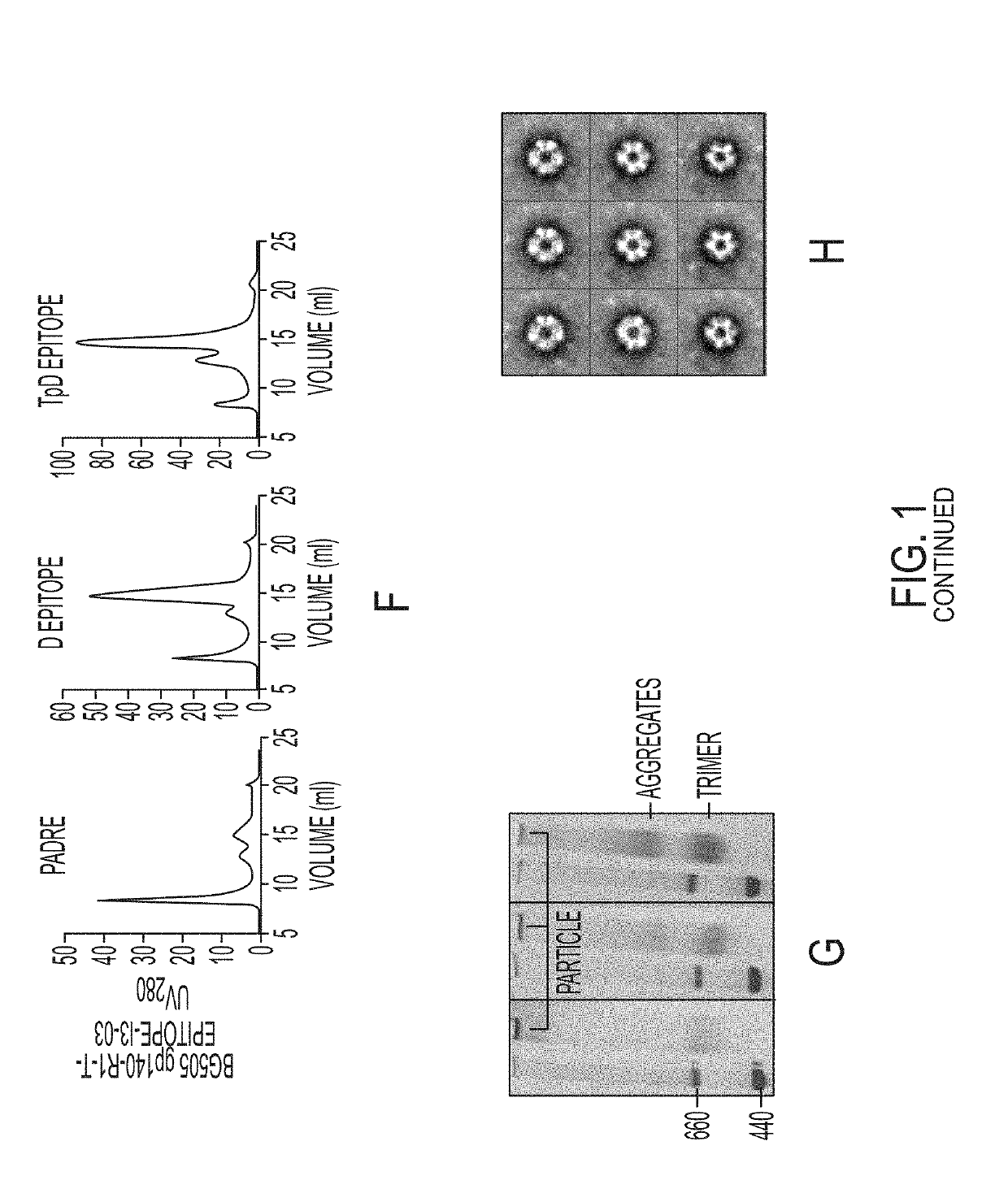Novel Scaffolded HIV-1 Vaccine Immunogens
a scaffolded, hiv-1 vaccine technology, applied in the direction of antibody medical ingredients, peptide/protein ingredients, peptide sources, etc., can solve the problems that the utility of nanoparticles as carriers to display native-like trimers has not been rigorously explored in hiv-1 vaccine development, and may not be the optimal form of hiv-i vaccines. to achieve the effect of preventing hiv-1 infection
- Summary
- Abstract
- Description
- Claims
- Application Information
AI Technical Summary
Benefits of technology
Problems solved by technology
Method used
Image
Examples
example 3
Nanoparticles Potently Activate B Cells Expressing bNAbs
[0075]Previously, we demonstrated that various BG505 gp120 and gp140 nanoparticles could engage B cells expressing cognate VRC01 receptors (He et al., 2016). In this study, we assessed the B cell activation by five UFO2-BG-FR nanoparticles and a BG505 gp140-PADRE-I3-01 nanoparticle with respect to individual trimers (FIG. 2). B cells expressing bNAbs PGT145, VRC01, and PGT121 (Ota et al., J. Immunol. 189, 4816-4824, 2012) were used in the assay. Overall, trimer-presenting nanoparticles could stimulate bNAb-expressing B cells more effectively than individual trimers, with peak signals approaching the maximal activation by ionomycin. However, the results also revealed a pattern pertinent to the epitope examined: when tested in B cells expressing PGT121, which recognize the N332 supersite, some trimers and all nanoparticles rendered detectable Ca2+ flux signals; by contrast, none and few trimers activated B cells expressing PGT145...
example 4
Induction of Autologous Neutralizing Antibodies in Wildtype Mice
[0076]Immunogenicity has been assessed for various forms of native-like Env trimers. When wild-type mice were immunized with SOSIP trimers, no autologous tier-2 NAb response to BG505.N332 was observed over a period of eighteen weeks (Hu et al., J. Virol. 89, 10383-10398, 2015). It was concluded that the glycan shield of well-formed Env trimers is impenetrable for murine antibodies due to their short heavy-chain complementarity-determining region 3 (HCDR3) loops. Nonetheless, tier-2 NAbs were reported to be elicited by modified BG505 SOSIP trimers in mice with knock-in bNAb precursors. Using vaccination regimens spanning six months to one year, native-like trimers were also reported to induce an autologous tier-2 NAb response in rabbits and a weaker such response in macaques (de Taeye et al., 2015; Klasse et al., 2016; Martinez-Murillo et al., 2017; Pauthner et al., 2017; Sanders et al., 2015). Therefore, the induction o...
example 5
Other Hyperstable Nanoparticles for Presenting HIV-1 gp140 Trimer
[0078]In addition to the I3-01 nanoparticle, we also examined other stable nanoparticles for constructing the gp140-T helper epitope-nanoparticle platform HIV-1 vaccine immunogens described herein. Specifically, we tested a protein “2-Dehydro-3-Deoxyphosphogluconate Aldolase4-Hydroxy-2-Oxoglutarate Aldolase (Tm0066) From Thermotoga Maritima” with a 2.30 Å-resolution crystal structure (PDB ID: 1VLW). The 1VLW-encoding gene sequence was used as a basis, with the 2.30 Å-resolution crystal structure used as the backbone, to design proteins that may automatically assemble into 60-meric nanoparticles with more desirable properties than I3-01. Eleven amino acids within the 1VLW sequence (SEQ ID NO:5) were subjected to the ensemble-based protein design, or visual inspection followed by manual design. Twelve designed 1VLW mutants were synthesized (SEQ ID NOs:6-17). Construction of gp140 trimer displayed on nanoparticles of thes...
PUM
| Property | Measurement | Unit |
|---|---|---|
| concentration | aaaaa | aaaaa |
| molecule weight | aaaaa | aaaaa |
| diameter | aaaaa | aaaaa |
Abstract
Description
Claims
Application Information
 Login to View More
Login to View More - R&D
- Intellectual Property
- Life Sciences
- Materials
- Tech Scout
- Unparalleled Data Quality
- Higher Quality Content
- 60% Fewer Hallucinations
Browse by: Latest US Patents, China's latest patents, Technical Efficacy Thesaurus, Application Domain, Technology Topic, Popular Technical Reports.
© 2025 PatSnap. All rights reserved.Legal|Privacy policy|Modern Slavery Act Transparency Statement|Sitemap|About US| Contact US: help@patsnap.com



